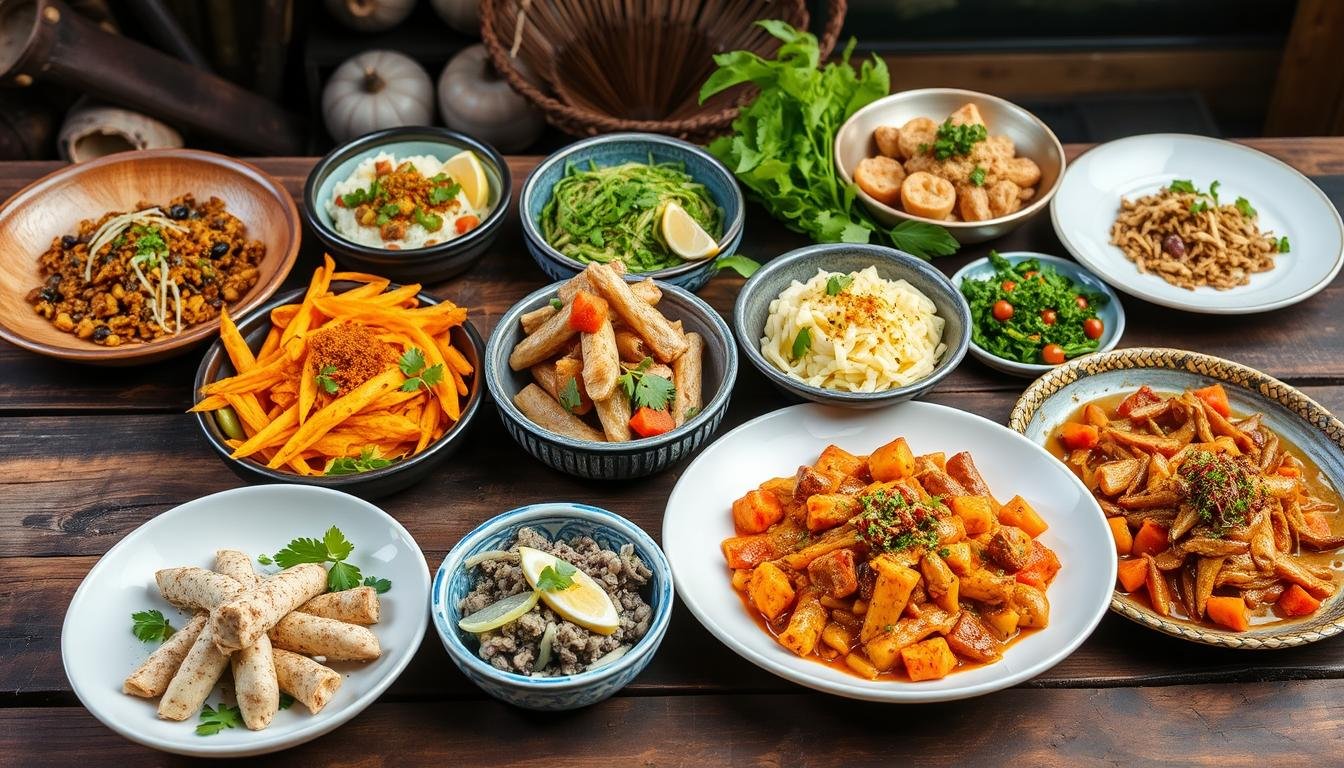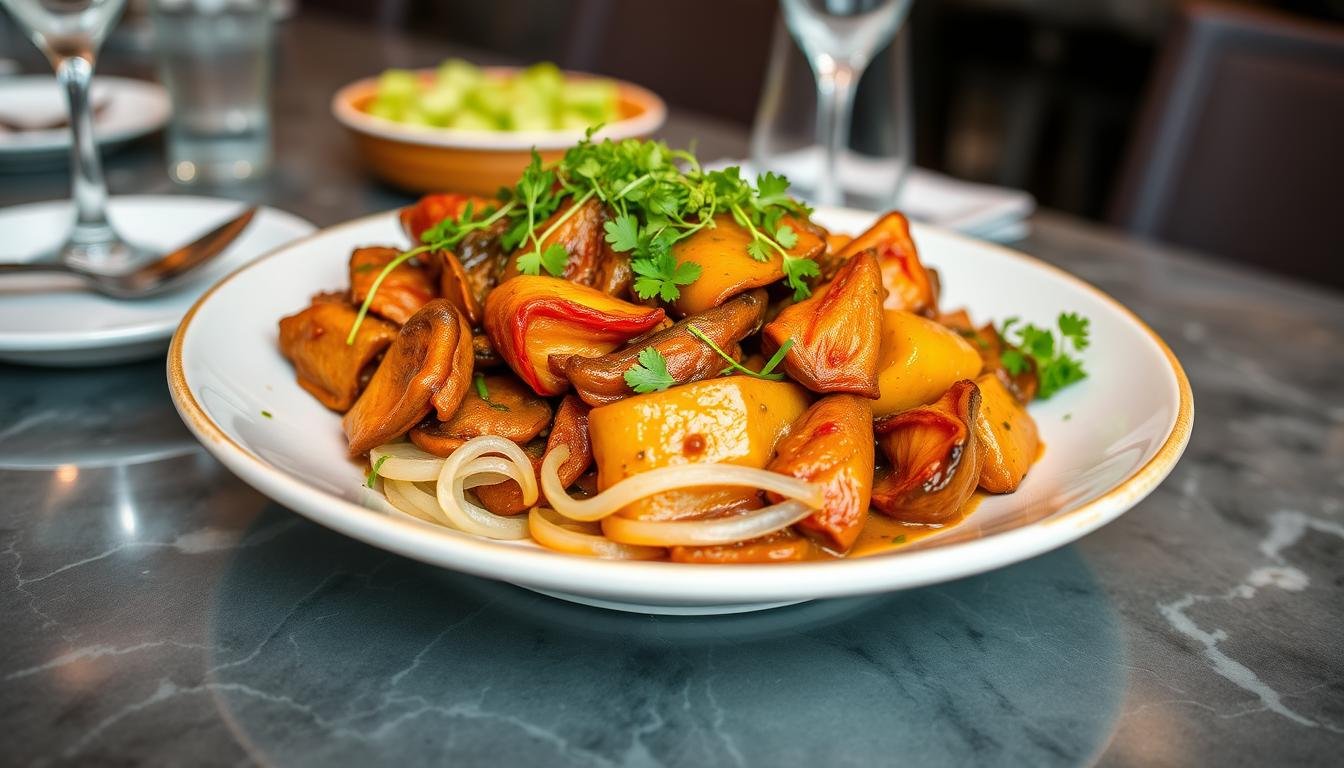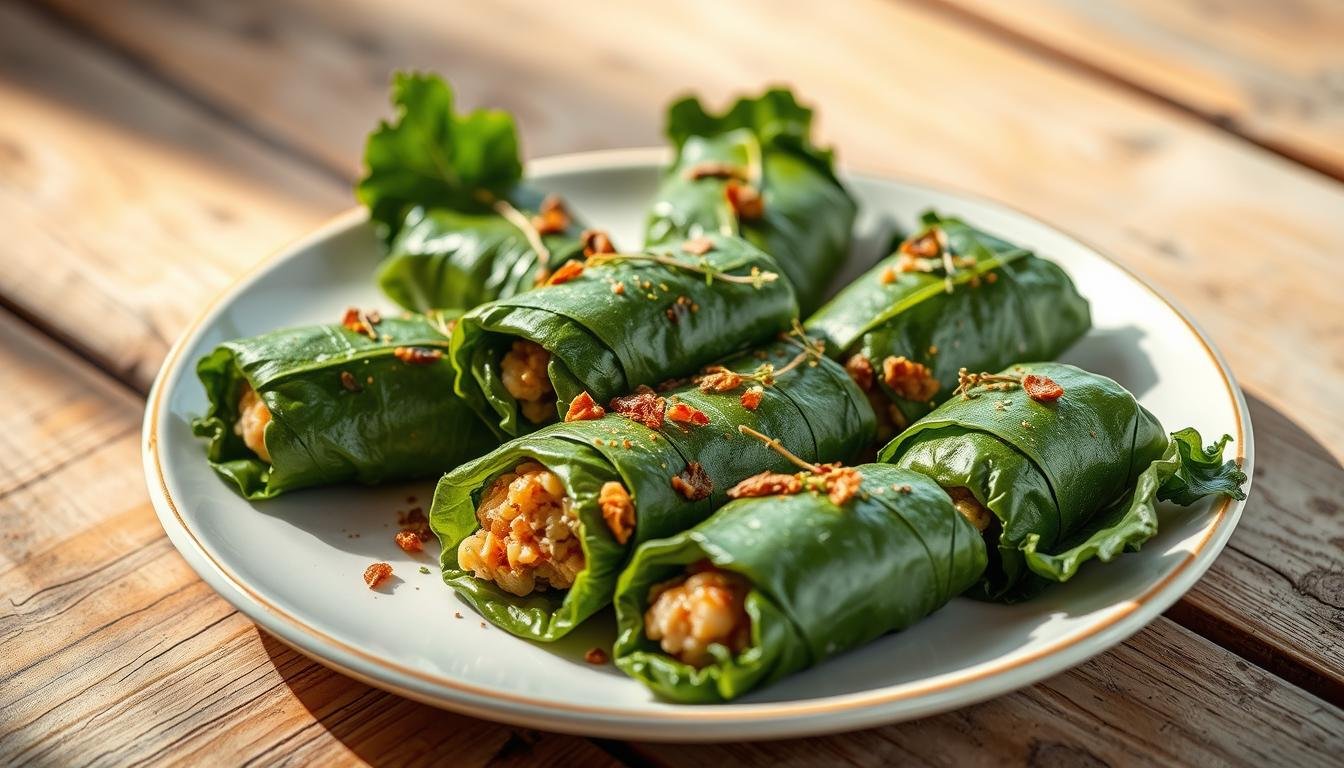Have you heard of “Kaleskes,” a Greek-inspired seafood dish from the Philippines? It’s a favorite among food lovers across the country. But what is Kaleskes, and where can you find it?
Kaleskes is a seafood dish with roots in Greek and Filipino cultures. It uses small fish, known as “Kaleskes,” in its preparation. Over time, it has mixed local flavors with Mediterranean tastes, keeping its unique essence.
Key Takeaways:
- Kaleskes is a traditional Greek-inspired seafood dish that has become a beloved delicacy in the Philippines, particularly in the Pangasinan region.
- The dish features a unique blend of Mediterranean and local Filipino flavors, with a focus on fresh seafood as the primary ingredient.
- Kaleskes has a rich cultural history, tracing its roots back to the cultural exchange between Greece and the Philippines.
- The dish has evolved over time, incorporating local ingredients and techniques while still maintaining its core Mediterranean characteristics.
- Kaleskes is a must-try for food enthusiasts looking to explore the diverse culinary heritage of the Philippines.
Ingredients and Preparation
Making the classic Kaleskes dish needs careful picking of fresh, top-notch ingredients. These ingredients mix to give it a unique taste and feel. At its core, it uses small, local fish like anchovies or sardines for a seafood flavor. Tomatoes, onions, and garlic add to the dish’s rich taste.
When picking seafood for your Kaleskes, choose the freshest you can find. Look for small, shiny fish without any signs of spoilage. The quality of the seafood greatly affects the dish’s taste, so invest in the best ingredients.
Essential Ingredients for Kaleskes
- Small, fresh fish (such as anchovies or sardines)
- Tomatoes
- Onions
- Garlic
- Olive oil
- Variety of herbs and spices
Tips for Selecting the Freshest Ingredients
- Check the seafood for freshness, looking for bright eyes, firm flesh, and a pleasant ocean smell.
- Pick tomatoes that are plump, juicy, and without blemishes.
- Choose onions and garlic that are free of sprouts and look vibrant and crisp.
- Use high-quality olive oil to boost the flavor.
- Try different herbs and spices to make the taste your own.
The traditional way of making Kaleskes involves detailed steps to highlight each ingredient. From cooking the vegetables to seasoning the seafood, the techniques show Pangasinan’s rich culinary history.
| Ingredient | Quantity |
|---|---|
| Small, fresh fish (anchovies or sardines) | 1 kilo |
| Tomatoes | 6 pieces |
| Onions | 2 pieces |
| Garlic | 5 cloves |
| Olive oil | 1/4 cup |
“The secret to a truly exceptional Kaleskes lies in the quality of the ingredients and the care taken in the preparation. Every step, from selecting the seafood to seasoning the dish, is crucial in creating the perfect balance of flavors.”
Variations and Regional Differences
Kaleskes is loved across the Philippines, especially in Pangasinan. But, each region has its own twist. These differences show how diverse and rich Philippine cuisine is.
Kaleskes Across Pangasinan
In Pangasinan, you’ll find a mix of cuisines. This includes dishes from Spanish, Chinese, and American traditions. Some popular dishes are kinurkor a ponti, binolbol, and corn soup with ampalaya leaves.
Other favorites include utong na kamote salad, inkelnat a katuray, and pakbet. You’ll also find bulanglang, ginisan papait, and ginisan kamatis with egg. Don’t miss ginisan balatong, ginisan apayas, pising ya inangel, and ginataan ya kamansi or langka.
Unique Ingredients and Preparation
Bayambang’s meat dishes are a mix of traditional Filipino and local flavors. You’ll find bagisen (local dinuguan), lauya, and adobo-style pork. There’s also goat meat caldereta, pinapaitan a kanding, and igado.
Fish and seafood dishes are just as varied. Try malangsi fish dishes, buro, and inselar a karpa. Don’t miss inselar a pantat, potseron dalag, and ingkalot a sira (grilled fish). Ginataan a alireg, ginataan a larangan, and kuros (sun-dried small river shrimps) are also must-tries.
The unique ingredients and cooking methods in Pangasinan make Kaleskes special. They reflect the region’s culture and culinary traditions.

Kaleskes and Other Filipino Seafood Dishes
Kaleskes is a favorite in the Philippines, much like Sinigangan. Both dishes celebrate the sea’s bounty. Yet, they have different cooking styles, tastes, and seafood choices.
Comparing Kaleskes and Sinigangan
Sinigangan comes from Bicol and is a coconut milk stew. It has shrimp, fish, squid, or crab. On the other hand, Kaleskes from Pangasinan is a soup with cow or carabao innards, scallions, and broth.
Both dishes highlight Filipino cooking’s variety. But, their ingredients and cooking methods make them unique.
| Kaleskes | Sinigangan |
|---|---|
| Soup made with cow or carabao innards, scallions, and broth | Coconut milk-based stew with seafood like shrimp, fish, squid, or crab |
| Originates from Pangasinan province | Specialty from the Bicol region |
| Savory, sometimes with a spicy kick | Rich and creamy in texture |
| Often enjoyed alone or paired with other Pangasinan dishes | Typically served with steamed rice |
Learning about Kaleskes and its differences from other Filipino seafood dishes deepens our appreciation for the Philippines’ culinary diversity.
Kaleskes in Contemporary Cuisine
In recent years, Kaleskes, a beloved dish from Pangasinan, has become more popular in modern Filipino restaurants. Chefs love its unique flavors and versatility. They experiment with fusion recipes and gourmet twists, making Kaleskes a modern favorite.
The Popularity of Kaleskes in Modern Filipino Restaurants
Kaleskes is now a must-try in many modern Filipino restaurants. Places like Mangan-tila Restaurant in Pangasinan highlight this dish. Food critics say it’s “truly to die for,” attracting both locals and tourists.
Innovative Twists and Fusions with Kaleskes
- Chefs mix Kaleskes with other flavors, showing its versatility.
- They’ve added Kaleskes to Sisig, a dish from Pampanga, creating a new flavor.
- Restaurants also use Kaleskes in modern Filipino cuisine, trying new cooking and presentation styles.
Kaleskes’ inclusion in modern cuisine keeps its cultural value alive. It also shows the endless possibilities of combining traditional recipes with new ideas. As it continues to attract diners, Kaleskes is set to become a key part of Filipino cuisine‘s growth and global fame.

Where to Find Kaleskes
If you’re visiting the Philippines, especially Pangasinan, you’ll find Kaleskes everywhere. This seafood delicacy is loved by locals and tourists alike. You can enjoy it at many restaurants and food stalls. These places, often family-run, serve top-notch Kaleskes.
Popular Restaurants and Food Stalls in Pangasinan
When looking for Kaleskes, choose places that use fresh, local ingredients. They should stick to traditional cooking methods. This way, you get a true taste of this special dish. Some top spots in Pangasinan for Kaleskes include:
- Dagupan Kaleskes, which has been around since 1954, with over 65 years of history.
- Places that offer a wide range of meat parts, like intestines and hearts, for a unique taste.
- Restaurants that serve Kaleskes for just 50 Php per bowl, making it affordable for everyone.
- Spots that serve Kaleskes from 4 PM until early morning, perfect for late-night cravings.
Tips for Finding Authentic and High-Quality Kaleskes
For the best Kaleskes, look for places that focus on quality. Choose restaurants and stalls that use fresh, local ingredients and traditional cooking. This way, you’ll enjoy a delicious Kaleskes that truly represents Pangasinan’s food culture.
“Kaleskes is a must-try for any food enthusiast visiting Pangasinan. The perfect blend of flavors and textures makes it a true delight for the senses.”
Conclusion
The story of kaleskes delicacy is fascinating. It started in Greece and became a key part of Filipino food. This shows how cultures mix and adapt, creating a rich food scene in the Philippines.
Kaleskes is more than just a dish. It connects Pangasinan to the sea and shows the importance of seafood in Filipino food. Exploring its flavors and history, you’ll see the effort to keep culinary traditions alive.
If you love food or want to learn about Filipino culture, kaleskes is for you. It’s a chance to enjoy delicious flavors and learn about the cultural importance of this dish. It’s a true treasure in the Philippines’ food world.
FAQ
What is Kaleskes?
What are the key ingredients in Kaleskes?
How important is the quality of the fish in Kaleskes?
How does Kaleskes differ from other Filipino seafood dishes?
How has Kaleskes evolved over time?
Where can I find authentic Kaleskes in the Philippines?
Source Links
- Pancit Malabon | Panlasang Pinoy Meaty Recipes
- Kaleskes Recipe | Panlasang Pinoy Meaty Recipes
- Pangasinan comfort food: Dagupan Kaleskes
- An acquired taste: Dishes that define Bayambangueño cuisine
- Guide to Merienda in the Philippines: Best Classic Filipino Snacks | Guide to the Philippines
- Glossary of Filipino Food
- Top 10 Pangasinense Dishes and Delicacies You Should Try
- Pangasinan Food Trip: Four Locations, One Day, Amazing Food — Zoy To The World
- Dagupan City’s Kaleskes:
- Beyond Adobo: 6 Regional Delicacies to Try in the Philippines –
- Sparkle hunks bring a taste of Pangasinan to Quezon City
- Exploring the Culture of Pangasinan: Traditions & Arts
- Dagupan
- CALASIAO, PANGASINAN MAYOR KEVIN MACANLALAY | League
